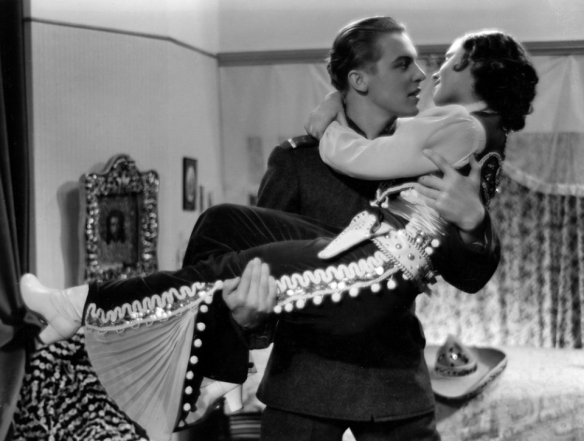 1916: and a battalion of German soldiers are off to fight on the Eastern Front. Wait. German? No, these are Finns, trained in Germany as elite “jaeger” fighters, although if the opening scenes are anything to go by, they certainly haven’t learned any manners. Somewhere in Latvia, the dancer Sabina (Tuulikki Paananen) is struggling to board the jaeger train. Her new-found guardian, the monocled Baron Lichtenstein (Erkki Uotila) gets into a fight with the young jaeger officer Martti (Kullervo Kalske), which leads to Martti being carted away to the brig.
1916: and a battalion of German soldiers are off to fight on the Eastern Front. Wait. German? No, these are Finns, trained in Germany as elite “jaeger” fighters, although if the opening scenes are anything to go by, they certainly haven’t learned any manners. Somewhere in Latvia, the dancer Sabina (Tuulikki Paananen) is struggling to board the jaeger train. Her new-found guardian, the monocled Baron Lichtenstein (Erkki Uotila) gets into a fight with the young jaeger officer Martti (Kullervo Kalske), which leads to Martti being carted away to the brig.
In nearby Libau, Martti languishes in jail, singing interminably all the while and drawing a picture of Sabina on his cell wall. He has, inexplicably, fallen in love. Sabina, meanwhile, dances at the Golden Anchor restaurant, a rowdy ale house frequented by the jaegers, as well as Isak (Sasu Haapanen), a Suspicious Jew. The talk of the town is “Merovich”, a Russian super-spy who is ruining the Germans’ chances on the front. Except we have already seen the Baron passing a coded message to Isak at the train station – the Baron is Merovich, and we have to sit through a bunch of songs and half-hearted dance routines while waiting for the Finns to work this out. Martti is an odd protagonist in that he spends most of the film in prison, singing about a girl he has only just met.
Risto Orko’s Jääkärin morsian is a notorious film in Finnish cinema history. It lionises the German-trained jaeger battalion that was fated to swoop into Finland after the Russian revolution and play a vital part in the liberation of the country from the Communists. As a result, by 1948 it was regarded as dangerously anti-Soviet propaganda, and after protests from Moscow it was effectively banned for the next four decades. Yes, it was a problematic film because it was anti-Russian, and not because of the shameful portrayal of Jews as craven, hunched, swarthy traitors. Your mileage may vary.
Baron Lichtenstein is clearly marked as the master-spy Merovich from the opening scenes, turning the film into a waiting game as we twiddle our thumbs through all the pointless singing, as his local paramour Sonja (Ritva Aro) fumes that he has found a younger woman, and the merry Russian serving wenches flirt and banter with the raucous Finnish soldiers. Eventually, the Finns work out who has betrayed them, and there is a horseback chase, a bomb rigged to blow up a manor house, and a bunch of people shot off-screen. In the role of the fiery Sabina, Tuulikki Paananen gets to show off the skill that first brought her to the attention of directors from Suomi-Filmi, which was apparently her party-piece of dressing up as a Mexican bandit and dancing to a tune that only she could hear, while the soundtrack plays something entirely different.
The fascinating thing about this film is the Eastern European world it depicts, thrice-destroyed in the twentieth century by the First World War, the Second World War and then a generation under the Warsaw Pact. Prussia just isn’t a thing any more, but here we see its restaurants, manors, peoples and fashions. There are foreshadowings here of some alternate-universe Casablanca, perhaps titled “Everybody Comes to Sonja’s”, in which the German dastards are here switched into heroes, and songs are clumsily integrated into the narrative while a pretty girl wanders through the action in a sombrero.
Although her dance sequences are ruined by a poorly synched soundtrack, Tuulikki Paananen smoulders impressively as the innocent dancer Sabina. The child of a Finnish father and an American mother, Paananen was raised in the United States and would return there soon after the outbreak of the Winter War in 1939. Local rumour in Finland held that she has been arrested as a spy, but in fact she was trying to carve out a career in Hollywood. In the 1950s, she moved to Honolulu, where she ran a hula school. You really couldn’t make this up.
Jonathan Clements is the author of An Armchair Traveller’s History of Finland.
















